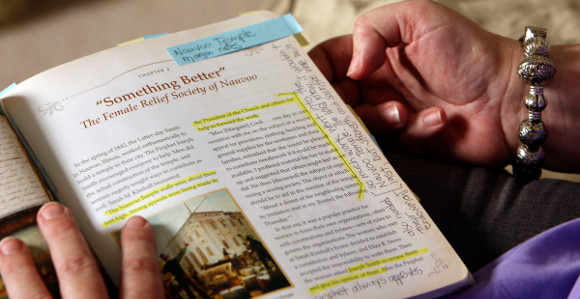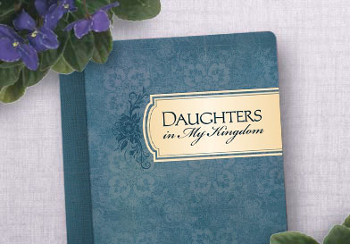5th Anniversary of “Daughters in My Kingdom”: Preserving the Heritage of Latter-day Saint Women
Contributed By Rachel Sterzer, Church News staff writer

Daughters in My Kingdom is described as a gift to the women of the Church.
Article Highlights
- Men and women work in partnership to live the gospel.
- The goal of Daughters in My Kingdom is to convey a spiritual legacy of faith, family, and relief.
- Many miracles happened throughout the publication process of this compelling book.
“In the way it was given and for what it contains, Daughters in My Kingdom has become a gift to those who have received it.” —Sister Julie B. Beck, former Relief Society general president (2007–2012)
Related Links
In offering the keynote address as part of the Church History Symposium on March 4 in the Conference Center's Little Theater, Julie B. Beck explained that her speech “could be said to be my testimony or witness of the truthfulness of the Lord’s work on the earth and of Daughters in My Kingdom as an example of His work.”
Sister Beck, during her tenure as Relief Society general president from 2007 to 2012, spearheaded the effort to produce Daughters in My Kingdom, which is a record of the legacy of Relief Society and the women of the Church.
Now five years after its original publication, Sister Beck shared her own recollections and insights into the process of creating Daughters in My Kingdom and its contribution to the Church today.
Sister Beck began by reviewing the backdrop for the publication, including her initial call to serve as Relief Society general president. She recalled being issued the invitation by priesthood leaders “to be partners with the First Presidency and the Quorum of the Twelve Apostles at a time of inflection, or a ‘hastening’ of the work of salvation. We were given insight into how they saw the Church moving forward, and we received a confirmation of their charge to take the gospel into all the world.”
Not long after her presidency was set apart, Sister Beck said they were confronted with some “prominent and damaging myths regarding the women of the Church and Relief Society.”
Such “myths” included misperceptions that women were second-class citizens, that Latter-day Saint women were sweet but uninformed, or that Relief Society’s season was waning.
“It became obvious that if the women of the Church felt obscure or were seen as obscure, then a large percentage of the Church population would not be engaged in hastening the Lord’s work,” Sister Beck explained.
In addition, they discovered that there seemed to be confusion about who Latter-day Saint women were and what Relief Society was about.
“We needed a way to transmit the true spirit and contribution of Latter-day Saint women, a way to communicate our purpose and achieve global alignment.”
In addressing these issues, Sister Beck said, they began by “going to school.” “As a presidency, we began to study the scriptures to look for any special patterns, instructions, or ‘breadcrumbs’ that could lead the way to what we were organized to do.”
In the scriptures they found that the Savior had a pattern of calling and organizing male and female disciples to assist Him in His work. They read of sisters having “business” as “helpers in Christ Jesus” (Romans 16:1-4) and being yoked with male disciples as “fellowlabourers” (Philippians 4:3).
“These and other learnings confirmed our belief that God expected and planned for a full commitment from His daughters as well as His sons in His work,” Sister Beck said.
They also studied academic works that taught about global communication and gave them insights into how organizations achieve lasting success. They studied as much Relief Society history as they could find and studied it again.
Eventually, they went to the First Presidency to see if they were on the right track and presented a paper that stated what they believed distilled the purpose of Relief Society: “Relief Society was organized to help sisters prepare for the blessings of eternal life as they increased faith and personal righteousness, strengthened families and homes, and provided relief to those in need.”
The First Presidency’s response was “a resounding ‘Yes!’” Sister Beck said. They now had a delineated purpose that could be stated in three words: “Faith, family, and relief.”
“Now that we were able to articulate a clear, straightforward purpose, we hoped to find a way to share the compelling story behind it,” Sister Beck said.
Then came the day that Sister Beck and her presidency received “a historic assignment” from the First Presidency and the Quorum of the Twelve Apostles to compile an official history of the Relief Society for the worldwide Church audience.
“In our discussions, we felt that this was not to be a historian’s history, a biography, a chronology, or a comprehensive history. It was envisioned as a record that would convey a spiritual legacy. It was to be the vehicle to carry our purpose into homes and hearts worldwide, to be understood and applied across cultures, languages, economies, and experiences.”
After pondering the assignment as a presidency, they recommended Susan W. Tanner to be called as the compiler and writer of the history.
Sister Beck said their presidency had prepared an outline or table of contents of what they thought the history should contain. Instead of giving it to Sister Tanner, however, they gave her all the material they had studied and asked her to get a feeling for the spirit of the work and to return when she had some idea of the content of the book.
Three months later, Sister Tanner called to say she was ready to share her impressions about the book.

The Relief Society book Daughters in My Kingdom.
“I remember with joy the moment she laid her proposed outline on the table,” Sister Beck recalled. “I then placed next to it the table of contents that had been revealed to our presidency months previously. The two outlines matched. We sat for a few moments, observing the tender, thrilling significance that we were being taught from on high—that we could now thrust forward with confidence in His power, being assured that He would give us what we needed to accomplish His work.”
Each team member brought in to work on the project, from designers to editors, “began to feel the Spirit of the Lord in individual efforts and in a variety of ways,” Sister Beck said.
In addition to a “continuous string of miracles and heavenly interventions” was “an almost constant opposition,” Sister Beck said. “Occasionally during the process, someone would become worried about not working fast enough or coming up against a roadblock that might derail it, but our feeling was to push forward each day, be at peace, and keep moving it.”
In a “miraculously” short amount of time, Daughters in My Kingdom was sent in the fall of 2011 to every Relief Society sister of the Church at no personal cost. “In the way it was given and for what it contains, Daughters in My Kingdom has become a gift to those who have received it.”
Sister Beck listed many of the truths discussed in Daughters in My Kingdom that illuminate the purpose of Relief Society.
“A review of Daughters in My Kingdom has filled me with gratitude for the examples and testimonies of capable, influential women who knew that through the ordinances of the gospel they had the gifts and power necessary to triumph over life’s challenges and to help others do the same. I am blessed by knowing that they spoke to God and understood when He spoke to them,” Sister Beck declared.

Julie B. Beck, then Relief Society general president, is interviewed August 30, 2011. Photo by Ravell Call, Deseret News.

Julie B. Beck, then Relief Society general president, speaks at a Brigham Young University devotional on January 17, 2012. Photo by Mark A. Philbrick.
